Make roasted cauliflower and asparagus with carrots using this easy recipe. Simply combine cauliflower, asparagus, and carrots on one sheet pan for a colorful, flavorful side dish that's quick and easy to prepare.
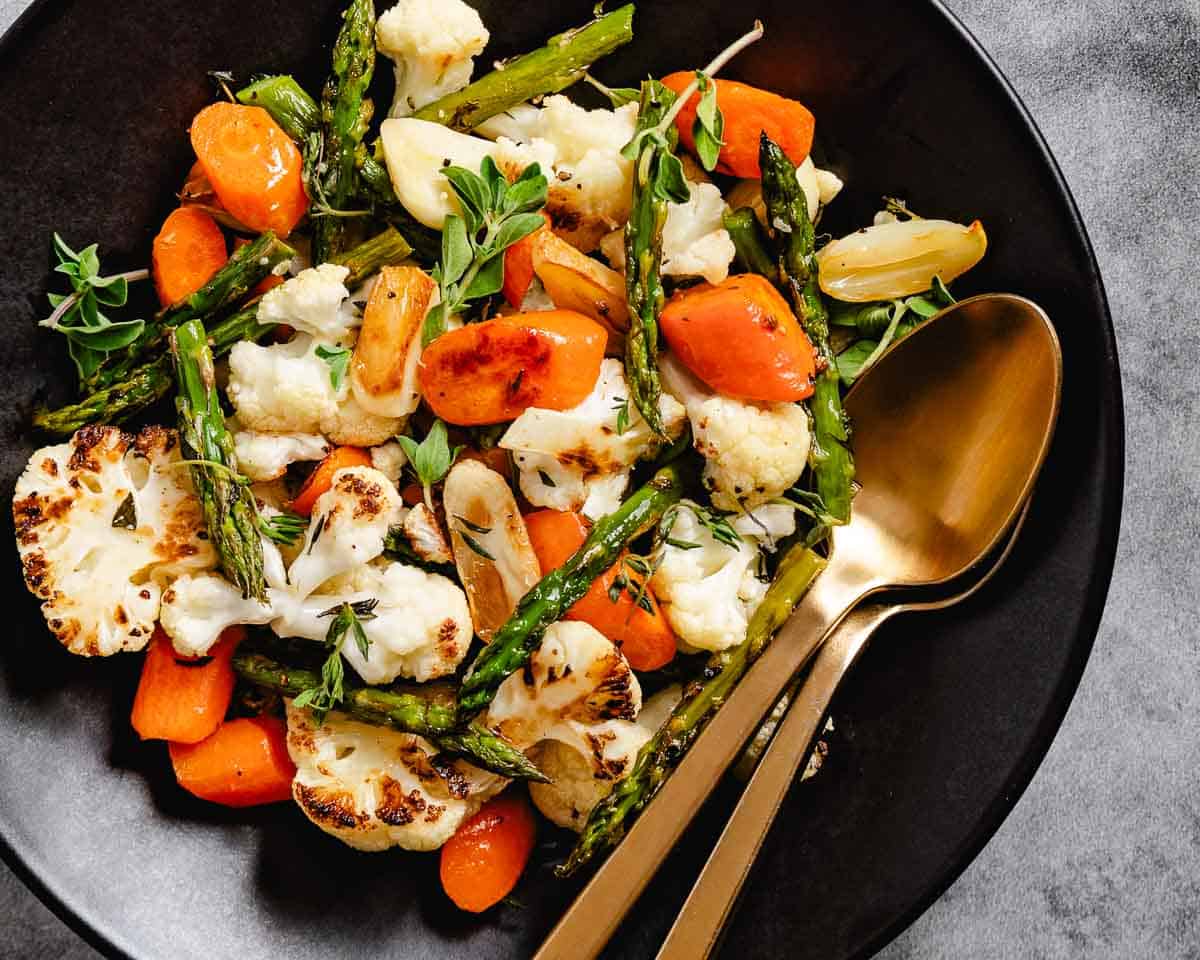
This roasted veggie medley is gluten-free, vegan, low-carb, vegetarian, paleo, and Whole30 compliant.
Jump to:
- Why We Roast Vegetables
- How To Roast Vegetables Evenly
- What You Need
- How to Roast Cauliflower and Asparagus
- Additional Seasonings for Roasted Veggies
- What Goes with Roasted Cauliflower and Asparagus?
- How to Reheat Roasted Vegetables
- Summary
- FAQ Roasted Cauliflower and Asparagus
- Roasted Cauliflower and Asparagus with Carrots
Why We Roast Vegetables
Roasting has the magical ability to transform ordinary vegetables into crispy gems with great flavors and textures.
In this post, I discuss how to roast different vegetables together on one pan.
Similar to how you would make a Cabbage Tomato Soup or Traditional French Ratatouille, this recipe is perfect for using leftover vegetables in your fridge as the weekend approaches.
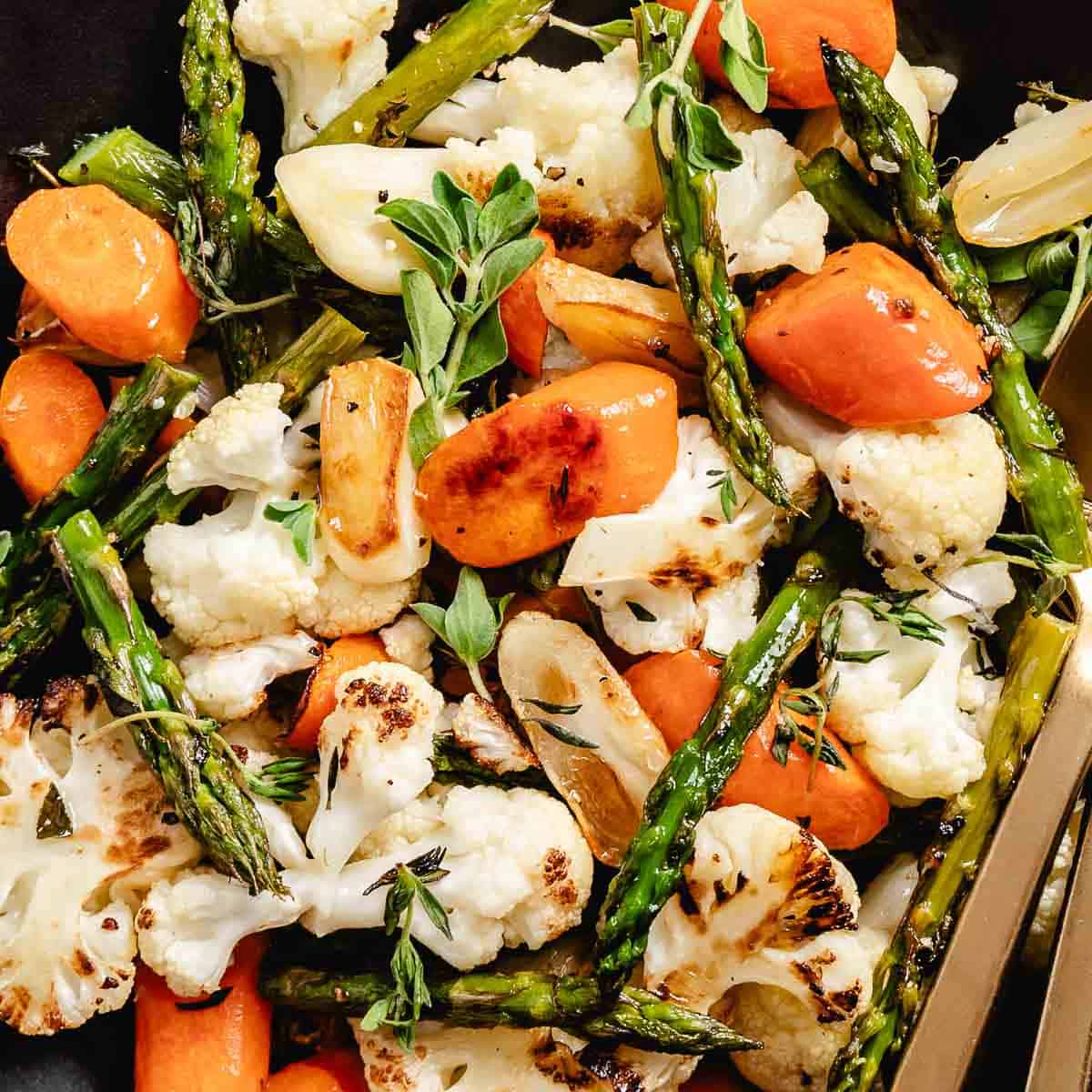
How To Roast Vegetables Evenly
For this roasted vegetable medley, I worked around the vegetable with the shortest cooking time— asparagus. To ensure everything roasts evenly, I sliced the carrots (which take the longest) into thin pieces, cut the cauliflower into small florets, and halved the garlic cloves.
I use a 13" x 18" sheet pan, which gives plenty of space, so I only need one pan. This prevents overcrowding, which can cause steaming instead of roasting.
Different vegetables cook at different rates, so cutting everything to similar sizes ensures even cooking and perfect texture.
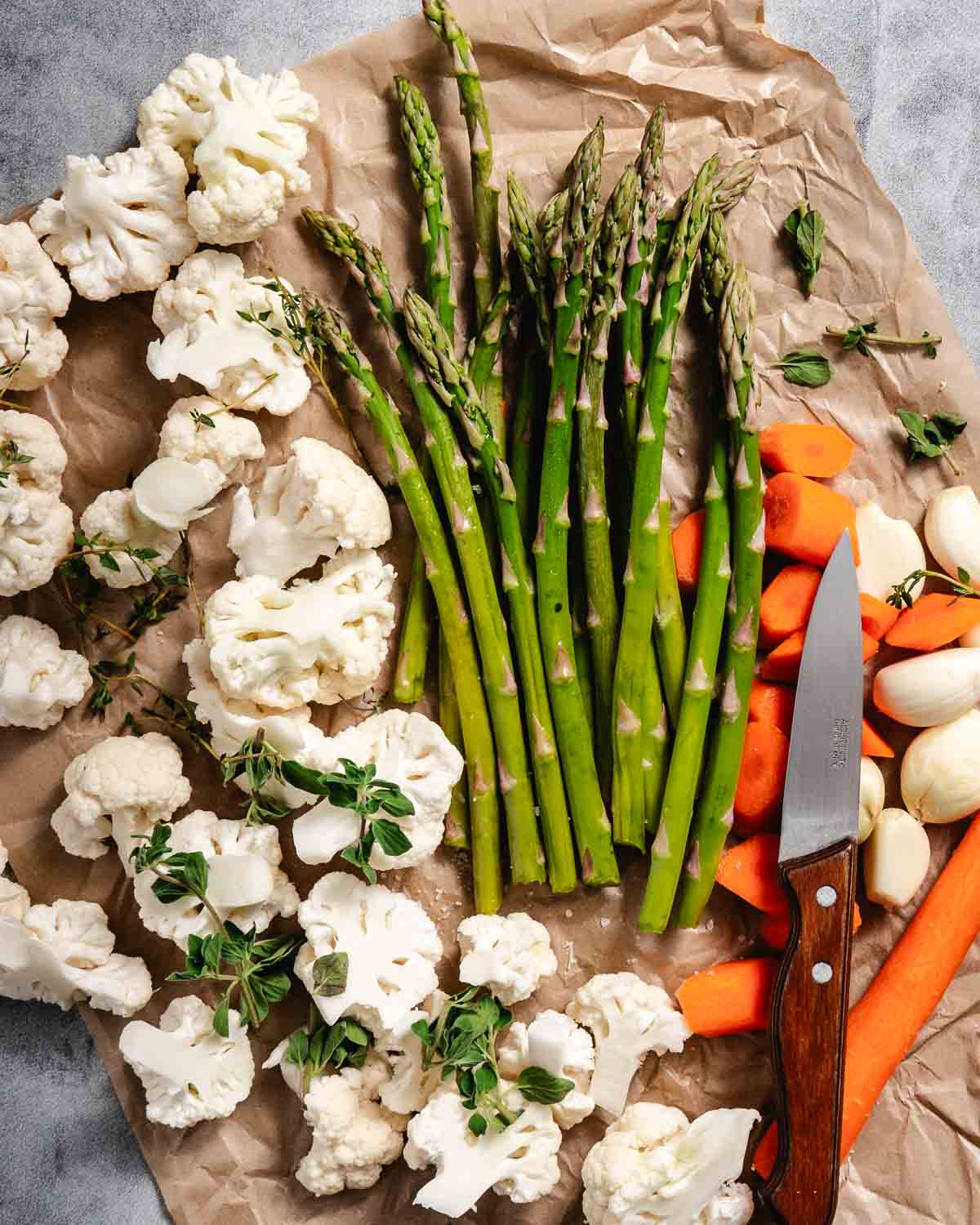
What You Need
Roasted vegetables need very little seasoning. The star of this dish is good fresh vegetables.
After that, you need olive oil, coarse salt, and freshly ground black pepper.
In this dish, I use fresh herbs to add a little seasoning and nutrition.
- Cauliflower (you can sub broccoli)
- Asparagus, medium spears
- Carrots (you can sub parsnips)
- Fresh garlic cloves
- Fresh thyme and/or oregano
- Extra virgin olive oil, avocado oil, or coconut oil
- Sea salt
- Black pepper
See the recipe card below for quantities.

How to Roast Cauliflower and Asparagus
- Preheat the oven to 400°F (204°C) and position the rack in the center.
- Line a large sheet pan with parchment paper or spray it with oil to prevent sticking.
- Rinse and dry all the vegetables.
- Slice cauliflower florets in half, peel and slice carrots into ¼-inch pieces, and snap off the asparagus ends.
- In a large bowl, toss cauliflower, carrots, fresh herbs, olive oil, ½ teaspoon salt, and pepper.
- Spread the cauliflower and carrots on one side of the sheet pan, leaving space between the pieces. Place asparagus on the other side and brush with oil; season with salt and pepper.
- Roast for 15 minutes, rotating the pan after 10 minutes. Continue roasting for 5-10 minutes, until the asparagus is golden.
- Adjust seasoning and serve hot.
Additional Seasonings for Roasted Veggies
- Red pepper flakes
- Lemon zest
- Chili powder
- Pine nuts
- Fresh parsley
- Fresh basil
- Freshly grated Parmesan cheese
What Goes with Roasted Cauliflower and Asparagus?
You can pair roasted vegetables with almost anything from salads, omelets, beans and rice. These are our favorite main courses that go perfectly with sweet roasted veggies.
- Roasted Yellowtail Snapper with Old Bay
- Roasted Lemon Basil Chicken
- Panko Fried Fish
- Oven Roasted Mahi Mahi
- Key West Sweet and Old Sour Chicken
- Baked Whole Red Snapper
- Broiled Snapper
- Seared Mahimahi with Basil Butter
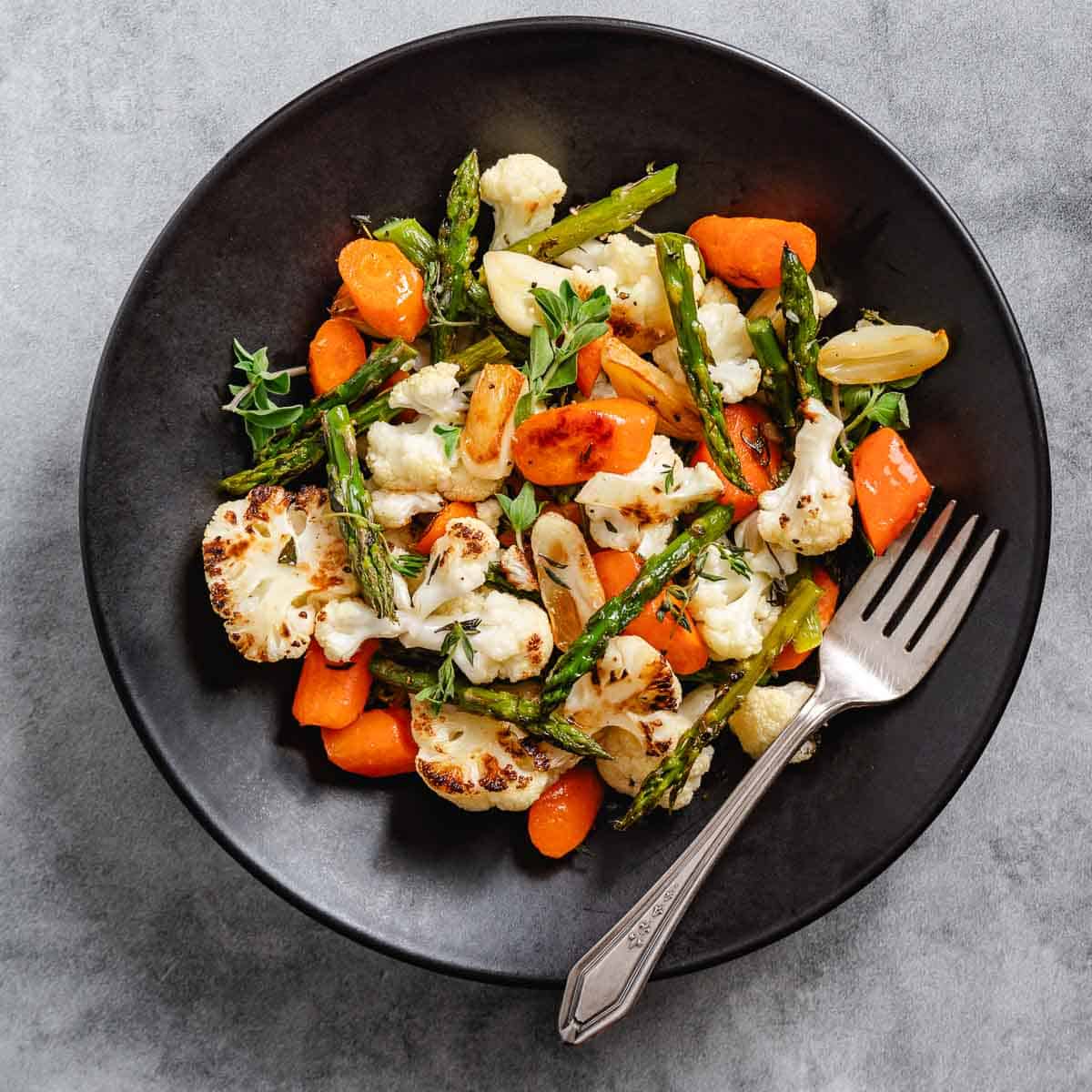
How to Reheat Roasted Vegetables
To reheat the vegetables, you can place them in the microwave for a minute. However, if you heat a little butter or coconut oil over medium heat in a small skillet, your vegetables will be healthier and tastier. It only takes 3 minutes.
Summary
My favorite way of eating vegetables is by roasting them. Roasted cauliflower and asparagus is one great roasted veggie combination. With the addition of carrots, the dish is sweeter and very colorful.
Toss the vegetables with olive oil, salt, and pepper, then spread them on a baking sheet. Roast in the oven until tender and golden brown. Roasting the veggies together simplifies meal prep and gets this healthy dish on the table in 20 minutes.
When roasting different vegetables together, choose those with similar cooking times to ensure even cooking. Additionally, cutting vegetables into uniform sizes helps them cook more evenly.
To successfully roast a vegetable medley, it's important to consider factors such as cooking times, vegetable size, and seasoning preferences. Adjusting the size and shape of the vegetables can help ensure they roast evenly.
This low-calorie side dish (136 calories per serving) would be a great side for fresh seafood or roasted chicken any night of the week.
Roasted veggies is a great dish for small dinner parties and holiday meals. Garnish your serving platter with fresh herbs such as oregano, thyme, and rosemary. Make it look extra special.
FAQ Roasted Cauliflower and Asparagus
Depending on many factors including the vegetables you're using, their age, how they were cut, and how they were stored, the vegetables will roast in 15 to 40 minutes.
Yes! Just be sure the vegetables you choose have similar cooking times and cut them into uniform sizes for even cooking. For better browning and crispness, make sure there’s space between the veggies so they don’t steam.
A large sheet pan works great for keeping everything spread out and helps the veggies get nice and crispy.
Cut the vegetables evenly: Cut the cauliflower and asparagus into uniform-sized pieces. This helps them cook at the same rate.
Use the right temperature: Preheat your oven to around 400 degrees F (220°C) for a good balance between browning and cooking the vegetables through without them becoming mushy.
Don't overcrowd the pan: Spread the vegetables in a single layer on a baking sheet. Overcrowding can lead to steaming instead of roasting, which may result in a softer texture.
Check for doneness: Check for doneness around the 15-20 minute mark. The vegetables should be tender and slightly caramelized but still have a bit of bite. Cooking times may vary depending on the size of your vegetable pieces, so keep an eye on them.
If your vegetables are soggy, you can try re-roasting them. Spread them out on a baking sheet and return them to a preheated oven at a higher temperature (around 400 degrees F or 230 degrees C). Keep a close eye on them and toss them occasionally. This can help remove excess moisture and crisp them up.
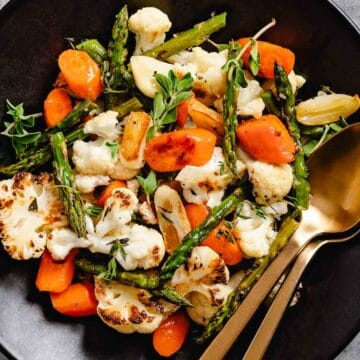
Roasted Cauliflower and Asparagus with Carrots
Ingredients
- 1 small head of cauliflower, broken into small florets.
- ½ pound medium width fresh asparagus, ends trimmed or snapped off
- 2 carrots, peeled and sliced into ½-inch coins
- 7 garlic cloves peeled and cut in half
- 5 sprigs fresh thyme snipped into 1" pieces
- 5 sprigs fresh oregano (optional) snipped into 1" pieces
- 2 tablespoons olive oil
- Kosher or coarse sea salt
- Freshly ground pepper
Instructions
- Preheat the oven to 400°F (204°C) and position the rack in the center.
- Line a large sheet pan with parchment paper or spray it with oil to prevent sticking.
- Rinse and towel dry all the vegetables.
- Slice cauliflower florets in half, peel and slice carrots into ¼-inch pieces, and snap off the asparagus ends.
- In a large bowl, toss cauliflower, carrots, fresh herbs, olive oil, ½ teaspoon salt, and pepper.
- Spread the cauliflower and carrots on one side of the sheet pan, leaving space between the pieces. Place asparagus on the other side and brush with oil; season with salt and pepper.

- Roast for 15 minutes, rotating the pan after 10 minutes. Continue roasting for 5-10 minutes, until the asparagus is golden.
- Taste and add more salt and pepper, if needed. Serve hot.







